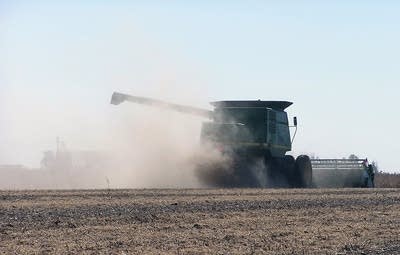Obama's deficit plan would cut ag subsidies by $33B

Most of the attention on President Barack Obama's plan to cut the deficit has been on his proposal to increase taxes on the wealthy. But another part of his plan would cut agriculture subsidies by $33 billion over the next decade.
Obama has already proposed some of these cuts before, as has Presidents George W. Bush and Bill Clinton. And all of those previous attempts failed under the weight of opposition from agriculture's many supporters on Capitol Hill.
But this time is different, said Don Carr, a senior policy adviser with the nonprofit Environmental Working Group, which opposes farm subsidies.
"Right now we've never seen a better climate to cut out some more of the wasteful spending," Carr said. "The constant refrain we hear in Washington, D.C. is 'Everyone is going to have to tighten their belts.'"
Create a More Connected Minnesota
MPR News is your trusted resource for the news you need. With your support, MPR News brings accessible, courageous journalism and authentic conversation to everyone - free of paywalls and barriers. Your gift makes a difference.
DIRECT PAYMENTS
The president's plan would end direct payments to farmers. In 2010, Minnesota farms collected more than $266 million worth of direct payments, according to data collected by the Environmental Working Group.
Those payments are particularly controversial because they get paid out regardless of how much a farm produces and they mostly go to big farms.
Political support has been eroding for this program for years and last year 7th District DFL Rep. Collin Peterson, one of Capitol Hill's agriculture experts, proposed ending direct payments.
Kevin Paap, president of the Minnesota Farm Bureau, said farmers need the payments and other programs to get them through hard times and to ensure that supermarket prices stay steady.
"Most of agriculture has had a couple of great years because of increasing world demand," Paap said. "But we don't write farm bills for the good years, we write farm bills for the unpredictability coming up."
CROP INSURANCE
Obama's other main cut would be in crop insurance, which protects farmers from bad weather. The Feds gave Minnesota farms $323 million in crop insurance subsidies last year.
The Obama Administration's proposal would cut about 10 percent of total spending on crop insurance — more than $8 billion nationwide over the next decade.
Last year, insurers, farmers and the government reached a deal that already saves $6 billion in spending from the crop insurance program.
But Paap said farmers aren't getting any credit for the cuts they already agreed to.
"If everybody did the same thing as crop insurance did, same as agriculture has done, we would see a much different budget than we've got," he said.
The president wants his proposal to be considered by the deficit reduction "supercommittee" that's meeting this fall to trim the long-term deficit by $1.5 trillion.
If the committee fails, a process called sequestration will kick in that makes automatic, across the board cuts of a similar amount.
Speaking last week before the president's plan was unveiled, Rep. Peterson said the one benefit to sequestration is that farm programs would get the same cuts as every other program.
"We're willing to do our part, but we just don't want to be singled out," Peterson said.
While Peterson isn't exactly rooting for the supercommittee to fail, he said farmers may be better off if it does because the automatic cuts would be less painful than anything either the committee or the president would come up with.
